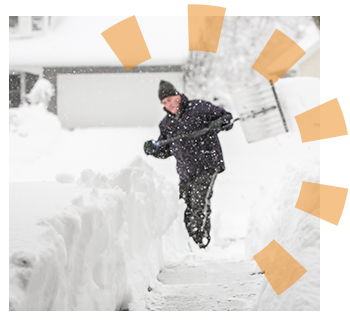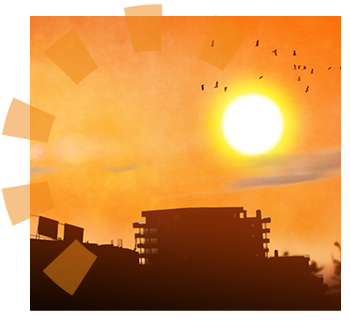Why Weatherproofing Your Dumpster Matters
Prepare your dumpster for the elements with our top tips for weatherproofing in any season.

How to Weatherproof Your Roll Off Dumpster
Renting a dumpster at different times of year means dealing with a variety of weather conditions. From safety concerns to the risk of extra fees, the challenges posed by extreme weather can be significant but with the right preparation are entirely manageable. With our help, you’ll feel confident navigating your dumpster rental no matter the weather.
3 Tips to Weatherproof Your Roll Off Dumpster
1. Cover Your Roll Off Dumpster With a Tarp
Protecting your dumpster with a tarp is a smart move, regardless of the weather forecast. A covered dumpster protects you from unwanted dumping from passersby. Covering your bin also prevents rain or snow from collecting inside, weighing down your debris and putting you at risk of an overage fee. Even on a dry day, strong wind can lift materials out of your dumpster, causing pollution and property damage.
How Do I Cover My Roll Off Dumpster?
Use a Heavy-Duty Tarp
We typically recommend the following tarp sizes for our dumpsters:
- 8’ x 16’ tarps for 10-15 yard dumpsters
- 8’ x 23’ tarps for 20-40 yard dumpsters
Secure the Dumpster Cover
Use bungee cords to fasten the tarp to your bin. Tie down the four corners and sides of the cover to fully windproof your dumpster.
Cover With Plywood
If you’re expecting heavy snowfall, place plywood over the tarp for extra protection. Remember to remove the wood before pickup.
2. Prepare a Drop-Off Area for Your Dumpster Rental
Severe weather can cause a few complications when you rent a dumpster, from slippery pavement to drifts of snow. Set yourself up for success with these steps for a clear workspace and delivery site.

Clear a Space for Your Dumpster
Choose a flat, paved area that’s free of obstacles including heaps of snow and low-hanging branches.

Salt a Pathway
In the case of snow or ice, salt the ground all the way from your workspace to your roll off dumpster delivery site.

Protect the Pavement
Lay plywood at the drop-off site to prevent scratches during delivery and pickup, especially in wet or icy conditions when the dumpster may shift.
3. Only Toss Accepted Materials
Extreme weather makes certain prohibited materials more dangerous than usual. Ensure a safe and stress-free cleanup by following the guidelines below.
Avoid Hazardous Materials
Prohibited items like paint, fuel and lithium batteries are especially dangerous in high temperatures. They may cause a fire or leak harmful chemicals, and should never be tossed in a roll off dumpster.
Toss Organic Waste Last
Take care to ensure that food waste is allowed in dumpsters in your area. If it is, on hot days be sure to throw it away last. High temperatures make food odor much worse, attracting insects or other critters.
No Wet Debris
Toss only dry items or seal wet material in a bag. Wet trash can freeze together or to the bottom of your dumpster rental. If items freeze together, a dig out fee applies.
The Do's and Don'ts of Dumpster Weatherproofing Infographic
View Infographic

How to Prep Your Dumpster for Rain and Wind
Arm yourself against stormy weather with the right materials to protect your dumpster. Review these suggestions to ensure you have everything you need on hand before delivery.

Tips to Prep Your Dumpster for Rain
1. Cover Your Dumpster
Strong gusts of wind can lift items out of your bin, causing pollution and damage to property. A properly covered dumpster keeps your debris both secure and dry.
2. Bag Small Objects
Put pillows, bedding and other fabric materials in plastic bags. If they absorb water, they will get heavier and could push you over your dumpster’s weight limit.
3. Cover Large Debris
Use large plastic bags or sheets to protect items like couches and rolls of old carpet. These materials weigh more when saturated, putting you at risk of an overage fee.

How to Plan for a Dumpster Rental in the Snow
When dealing with snow, dumpster rentals involve a few extra steps. In addition to clearing and salting your delivery space and bagging materials to keep them dry, prepare for a hassle-free winter cleanup with the following suggestions.
Tips to Prep Your Dumpster for Snow
1. Use a Tarp or Plywood Cover
Dumpster covers keep debris dry and snow-free. Choose a waterproof tarp and fasten it securely with bungee cords. In heavy snow, place plywood over your covered dumpster to reinforce the waterproof tarp.
2. Remove Cover Prior to Pickup
Be sure to remove your dumpster cover on your pickup day. Your dumpster should be uncovered and accessible so our driver can pick it up with ease.
3. Keep a Clear Path
Keep the path to your dumpster clear for pickup. If built up snow and ice prevent us from hauling away your roll off container, we’ll have to charge a trip fee and return when the path is clear.
How to Protect Your Roll Off Dumpster in Extreme Heat
Keep your summer dumpster rental safe and secure in even the highest temperatures with these tips.

Tips to Prep Your Dumpster for Heat
1. Cover Your Dumpster
For extra security, tightly cover your dumpster with a tarp to prevent others from illegally dumping waste without your knowledge.
2. Don't Toss Hazardous Materials
In extreme heat, it’s important to avoid tossing toxic chemicals, propane tanks and other hazardous waste, as they pose a serious fire risk.
3. Put Food Waste on Top
Check local restrictions before tossing organic waste and place it in your dumpster last to avoid odors caused by rotting food.
Weatherproofing FAQs
Should I put anything underneath my dumpster?
While it’s not required for delivery, you can place plywood on the drop-off site to protect the surface from damage. This also prevents your dumpster rental from freezing in place during cold weather.
What kind of dumpster covers work best?
Choose a heavy-duty tarp that fully covers your roll off container. Dumpster dimensions vary, but the recommended sizes are usually:
- For 10, 12 and 15 yard dumpsters, an 8’ x 16’ tarp
- For 20, 30 and 40 yard containers, an 8’ x 23’ tarp
Reach out to our team before your delivery date to find the exact dimensions of your roll off dumpster.
How do I keep rain out of my dumpster rental?
Tightly cover your roll off container with a waterproof tarp to protect it from rainwater and snow. If you discover water pooled inside, open your dumpster’s swinging door to help it flow out.
Will I receive a fee if snow collects on my roll off dumpster cover?
No, as long as you remove the snow-covered tarp or plywood and clear the area around your dumpster rental before pickup.
Get More Helpful Insight on Your Dumpster Rental
How to Rent a Dumpster
Everything you need to know to make your dumpster rental go smoothly.
Dumpster FAQs
Answers to all of our most commonly asked dumpster rental questions.
Service Dashboard
Manage every part of your dumpster rental in one convenient spot.
